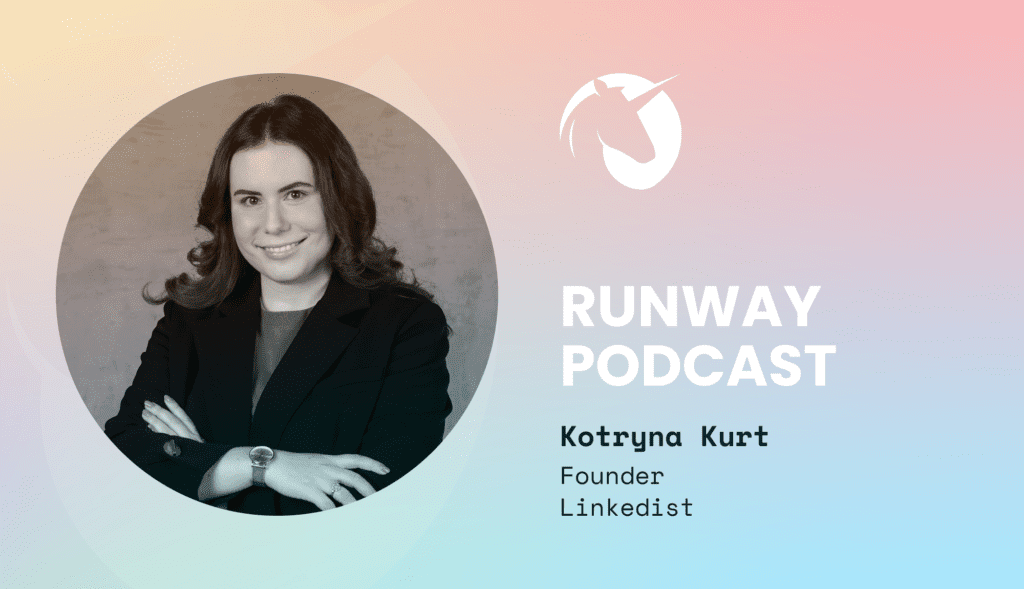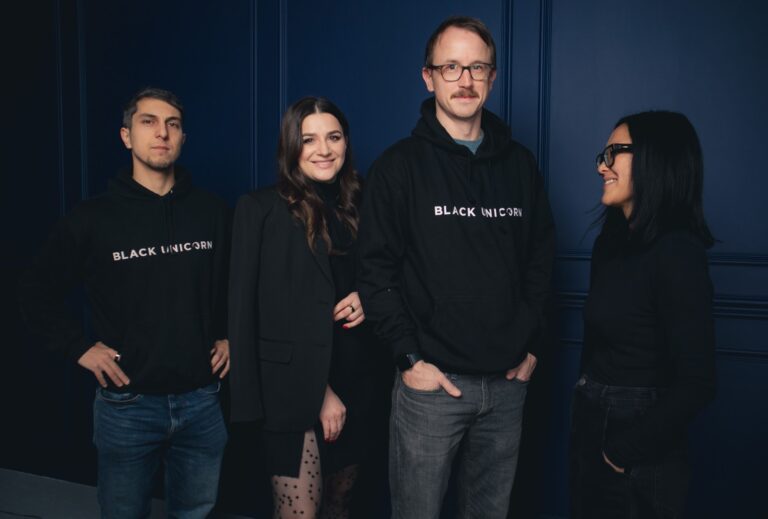In our latest podcast episode, we dive into the dynamic world of LinkedIn with a true expert, Kotryna Kurt. As a LinkedIn influencer, entrepreneur, and the founder of Linkedist, Kotryna shares her extensive knowledge on leveraging LinkedIn for startups, personal branding, marketing, and sales.
Join us in our conversation with Kotryna as we discover how businesses, especially startups, can harness its potential to drive growth. On the pod, she offers practical advice on optimising profiles, creating engaging content, and using LinkedIn’s features effectively. Whether you’re a CEO, marketer, or sales professional (all roles in which LinkedIn can be a game-changer), this episode is packed with valuable insights and actionable tips.
Below, you’ll find the full transcript of our conversation, filled with Kotryna’s strategies and experiences.
Tune in to learn how to make LinkedIn work for you and your business!
BONUS: By the way, Kotryna was so kind to share a special offer with Runway listeners and readers of the Black Unicorn PR blog. With the promo code UNICORN20 you can get a 20% discount on all their courses for the whole rest of 2024. It allows you to learn anytime from anywhere, test your knowledge with interactive quizzes and access handy documents quickly. Perk unlocked!
TRANSCRIPT
Julija Jegorova: Hello, everyone. Today, we’re very happy to have a LinkedIn influencer, entrepreneur, and agency owner, Kotryna Kurt, who will spill all the beans about LinkedIn and personal branding. Kotryna, thank you so much for joining us today.
Kotryna Kurt: Hello. It’s a pleasure. It’s a pleasure.
Julija Jegorova: So before we dive deep into the do’s and don’ts of LinkedIn and personal branding, Kotryna, do you mind just telling a little bit about yourself and the agency and what has inspired you to focus on LinkedIn in particular?
Kotryna Kurt: Sure. So during the last five years, I’ve been building Linkedist, and we are a niche marketing agency focusing solely on marketing on LinkedIn—social selling, advertising campaigns, you name it, everything that is connected and surrounding LinkedIn. The whole journey started actually nine years ago when I really started playing around with LinkedIn content and seeing what works and what doesn’t. That kind of inspired me, together with my co-founder, to try and see if we could help other brands grow and be more visible on LinkedIn, especially in terms of sales. So that’s how it all started. It was a very natural progression. I was just trying out something myself. I saw it work, saw that it generated results, and then from that, it grew into a business that is 10 people strong today, and we’re helping more than 20 brands at the same time.
Mauro Battellini: How would you say that LinkedIn fits into the overall marketing mix of an organization?
Kotryna Kurt: I believe it really depends, first of all, on whom you’re targeting, and whether or not you’re working with B2C or B2B. That’s where I usually start. If you are a B2B company, then that’s great. If you’re a B2C company, that’s also fine. You can still find your niche on LinkedIn, but mostly, LinkedIn is very beneficial for B2B companies. Once you know that, then we start talking about, okay, so when you’re B2B, which industries do you cover? Are your people—are those decision-makers—on the platform? Can we reach them? LinkedIn is very beneficial for B2B companies. It can be used as a sales channel, it can be used as a marketing channel, as you mentioned, and when it comes to marketing, it’s great for brand awareness. It’s great for warming up your potential clients and actually getting them as clients eventually.
Mauro Battellini: There’s been an interesting evolution in LinkedIn, right? I think when I first joined the platform, it was to put your CV online and find job opportunities and apply to them quickly. But somehow it transformed into a professional social media network. Can you give us an overview of how it evolved into that, and how different companies started getting results out of it?
Kotryna Kurt: I’ll start from the very first comment that you made about how this platform evolved during the last decade. Around 10 years ago, there were maybe 20 content creators around the world, and we all knew them by their names and last names. That was the beginning of when people started seeing LinkedIn as much more than just a platform where people upload their CVs, job descriptions, and whatnot. Slowly but surely, if you compare LinkedIn to other social media platforms like TikTok, Twitter, and Instagram, those platforms grew very fast. When it comes to LinkedIn, it grew very slowly but steadily. Till this day, we now have lots of different content creators. The platform is much more open to not only talking about work-related things but also lifestyle and other topics. This is where we are today. There’s also a big opportunity for startup founders, managers, and leaders to come in and brand themselves as professionals within their sphere or niche. Still, till this day, not a lot of people utilize that. Sometimes there’s a startup, and the CEO or other C-level people are not being active on LinkedIn, not being loud about what they’re building and doing. They’re missing out on a big opportunity. People should be active on this platform to generate better results for their business, reach a broader audience with personal content, and raise bigger amounts when it comes to fundraising. For every single person, there are different reasons—some want to be more present and be invited to top industry events. It’s up to you what you want to do with it, but there are definitely many ways you can grow a business and your personal brand.
Mauro Battellini: Is it fair to say that at this stage, LinkedIn has penetrated almost every aspect of how you carry out business, especially in B2B? Because it’s even a tool for sales almost directly. You can build an audience or influence how someone thinks about you through what you do on LinkedIn. In terms of the sales and marketing duality, where does it fit for a new organization or startup B2B? How should they think about setting up their LinkedIn?
Kotryna Kurt: Usually, a lot of startups use LinkedIn or Twitter as their go-to platforms to reach their target audience. The very first thing you should do on LinkedIn is set up a profile, make sure everything is optimized, and include all the right information about your company. Ensure all team members have added their roles to their profiles and are promoting it without doing much. That’s the hygiene we call it, that you should do before starting anything else. Once you have done that, look into your content creation strategy. Decide what you want to communicate, what events you have planned for the next couple of months, or what other important milestones you want to reach. Depending on those milestones, you can plan out your strategy and think of content pieces for your personal profile. Start with actions that would be more hygienic, so to say, like optimizations, feature sections added to your profile, and then focus on personal content creation. After that, if you have enough resources and maybe just raised capital, you can put some of your money into LinkedIn ads. But do that later in the journey, because many startups believe that when they start, they should put a lot of money into advertisement. However, people see their ads, click on the profile, and see the company page has 50 followers. That leads to more of a negative result than if you had a bit more mature profiles. Those are some of the first steps I would recommend. Of course, if you have a sales team, they could start using LinkedIn as their main source of lead generation, utilizing messaging campaigns and different sales tools to create a lot of buzz.
Mauro Battellini: If we can break it down, there’s the company level and the individual level, different individuals in an organization. There’s the founder, the CEO, or the general manager, director, then there’s salespeople, and the marketing team. For each of those stakeholders, what should be their priorities?
Kotryna Kurt: That’s a good one. For a CEO, the best tactic would be to start creating content and showcasing what they’re doing, what the startup is all about, how big the team is, and what their goals are. That should be the CEO’s and other co-founders’ goals. For the marketing team, their goal should be to build up the page and increase the following, ensuring followers come from the right industry and engage with the company’s posts. They should also create content themselves and ensure everyone on the team looks great with optimized profiles. For sales, they should focus on learning about their audience, using filters to target people, and understanding where their target audience hangs out on LinkedIn, whether that’s audio events or physical events in certain cities.
Julija Jegorova: My question is about general employees. When you are a C-level co-founder, you’re going to talk about the business because it’s your baby, and you have nurtured it for years. For someone in sales, they probably have some incentives. But for employees as ambassadors of the brand, sometimes their lifespan can be a couple of years or a couple of months. How can they stay true to themselves and authentic while working in a company? How important is it to have employees as ambassadors?
Kotryna Kurt: People who lead the company can set the tone, showing how it’s done. This encourages others in the team to be more proactive. Another action is to create an incentive system for everyone to aim for the same goal and have a reward. For example, at Linkedist, we aimed for 700,000 views in three months as a team, and the top responders got coffee coupons. It motivates people. You can also get someone externally to do a workshop and coach people, providing the right tools for LinkedIn content creation.
Julija Jegorova: Let me play the devil’s advocate here. LinkedIn is a wonderful platform, but sometimes there are silly stories like, “This weekend I got married, and here are 25 lessons for B2B marketers.” It feels off-putting for some founders to produce content because they think they have to do something like that. What do you have to say about it, Kotryna?
Kotryna Kurt: People make the platform, and the platform is as people make it. Whatever you see on LinkedIn today is not something LinkedIn is pushing out; it’s what people post. Platforms evolve naturally because of people. In the last couple of years, around 10 million new users joined LinkedIn. They don’t know how to act or what to do, leading to more Facebook-like posts. My advice is to make this platform work for you. Clean up your newsfeed regularly, mute some posts or people, and ensure the content you see is useful and valuable.
Julija Jegorova: For a content creator wanting to grow their following on LinkedIn, what should be the ratio between talking about the business and personal experiences? Does it matter? Do you have to post weekly or more often? Any guidelines and tips for founders?
Kotryna Kurt: If you want to be known as a professional in a specific niche, 80% of your content should focus on that topic. Otherwise, people will get confused. The 80/20 rule works well. Twenty percent of your content can be about anything else, like books you’ve read. For posting frequency, it depends on your goals. If you’re just starting out, start slowly. If you were silent for a year and suddenly post ten times a day, people will feel it’s not genuine. Start with a couple of posts a week and increase gradually. For huge results, you can post daily, but prioritize quality over quantity. Personal stories are always more appreciated. Some people want to be visible at all costs and post daily or even twice a day. It generates more views, but remember, quality is always better.
Mauro Battellini: You mentioned quality over quantity. What is quality on LinkedIn? How do you get the best responses and interactions considering the arsenal of tools available on LinkedIn—posts, images, videos, PDFs, slides, and LinkedIn articles? When should you use each tool?
Kotryna Kurt: Quality content is personal yet professional, with statistics and numbers to support your ideas. Experiment with different formats—videos, images, documents, audio events. For example, gallery posts with multiple images generate more views than a single image. Document posts in PDF format do well too. Videos are also important, especially with the new video newsfeed feature. Try videos and see how they work for you. LinkedIn boosts content related to their latest features, so videos might get more exposure right now.
Mauro Battellini: What about LinkedIn articles? And the famous question about links—everyone’s doing “link in the comments” and so on. When does it make sense to add a link directly, even if it means less engagement?
Kotryna Kurt: Articles are great for generating views over a longer period. They appear as unique links on Google search, increasing visibility. Recently, LinkedIn introduced thought leadership ads, allowing companies to sponsor personal posts, including articles, to get more views. As for links, it’s always better to use them in the comments. However, if you need to share a link directly in the post, it won’t hurt if you do it occasionally, like a couple of times a month. Just avoid doing it constantly, as it may hurt your views.
Julija Jegorova: I want to talk about the elephant in the room. With ChatGPT skyrocketing, I see a lot of people pushing out content. Sometimes, it’s every single word in capital letters, and people just copy-paste it, creating noise. What are your thoughts on using ChatGPT to create thought leadership pieces?
Kotryna Kurt: When ChatGPT first came out, I experimented by posting several posts generated by it. People didn’t realize they were AI-generated and engaged with them as usual. But as more people started using ChatGPT, it became obvious which posts were AI-written. Today, ChatGPT can be a base for your posts if you need help with structure or ideas. However, the core of your post should still be written by you or a ghostwriter. ChatGPT can’t write in a personal manner yet. In the future, it might be able to, but for now, personal stories get the best results.
Mauro Battellini: We’re nearing the end, but I don’t want to ignore the sales side. LinkedIn has two main products: one for recruiters and one for salespeople. I’ve heard a lot about social selling but don’t quite understand it. How would you incorporate LinkedIn effectively into the sales journey?
Kotryna Kurt: Social selling has become a hot topic, especially for startups. Prior to LinkedIn, salespeople used cold calling and email campaigns. LinkedIn offers a huge database of active users to connect and message. Start with simple campaigns, find your target audience, message them, connect, and interact with their content. Build relationships before trying to get them on a call. If you don’t have time, there are many sales tools you can use with LinkedIn for outreach. Understand your audience, do A/B testing, find the best message, and then use a tool for bulk messaging.
Mauro Battellini: Can you get bulk messaging right? Many people get irrelevant connection requests or messages. Is it because someone is doing something wrong or just playing a numbers game?
Kotryna Kurt: Most people who reach out with irrelevant messages don’t filter their audience properly. They might target all LinkedIn users in a specific location without proper filtering. It’s important to personalize messages. Tools have personalization options, like referencing someone’s last post. It comes down to how important your leads are. In niche industries, bulk messaging without personalization can ruin relationships. Avoid non-personalized bulk outreach. Use tools to personalize messages and build genuine connections.
Julija Jegorova: I received a pop-up notification, probably a sales thing, but it’s a voice memo. I’m not going to listen to it. Do people hate voice messages?
Kotryna Kurt: There are tools where you pre-record your message, and they copy your voice. You get a voice message that sounds personalized, but it’s actually automated. It can be scary where the world is going.
Mauro Battellini: That reminds me of a few years ago in the UK, there were a lot of robo calls with super robotic voices. Let’s hope it doesn’t happen with LinkedIn.
Julija Jegorova: To wrap up, could you share your top three do’s and three don’ts on LinkedIn for personal branding?
Kotryna Kurt: Sure. For the do’s: 1. Ensure you have an optimized profile that represents you well. 2. When creating content, don’t be discouraged if you don’t get many views initially. Stay consistent. 3. Use LinkedIn to build relationships and grow your personal brand. For the don’ts: 1. Don’t do bulk messaging without personalization—it doesn’t build great relationships. 2. Don’t misspell names or have grammatical mistakes in messages. 3. Avoid being silent and then suddenly posting excessively; it will seem inauthentic.
Mauro Battellini: I can’t tell you how many times I’ve been called Mario in emails or LinkedIn messages. Thanks for that advice.
Julija Jegorova: What is the best way for our listeners to get in touch with you besides on LinkedIn?
Kotryna Kurt: You can always reach out to me via my email kotryna@linkedist.com. You can also find me on Instagram with the same handle.
Julija Jegorova: Perfect. Thank you so much.
Mauro Battellini: Thanks, Kotryna.
Kotryna Kurt: Thank you.
Can’t get enough of the Runway pod? Check out these other episodes:
Affiliate Marketing 101 with Vik Ratomske of Partnergap
Adam Jennings on the foundations of branding
Silicon Valley veteran Gregory Kennedy on B2B startup marketing
Robin Wauters on European tech, the business of media and AI
Ex-Fortune editor Jake Meth on planning, writing and pitching the perfect op-ed



